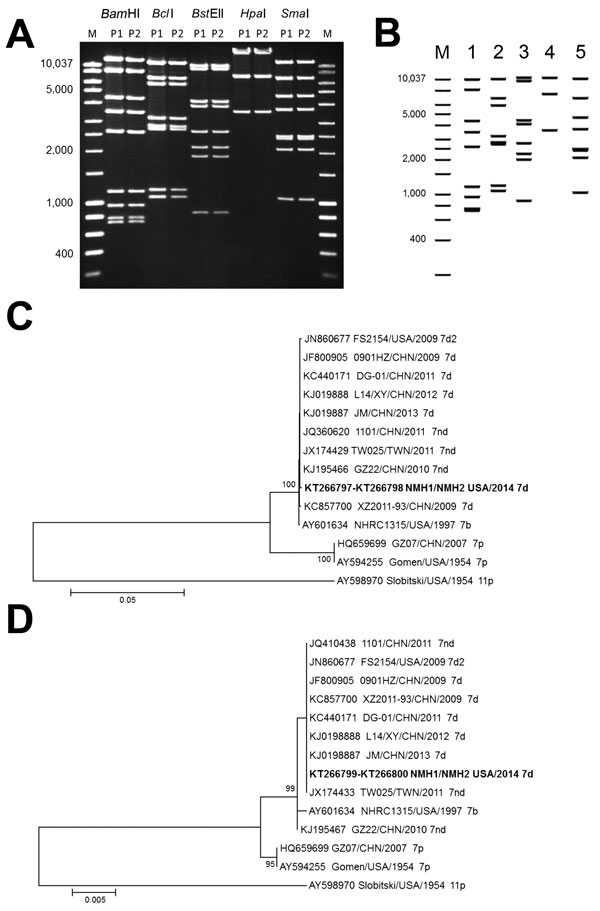Volume 22, Number 4—April 2016
Dispatch
Severe Infections with Human Adenovirus 7d in 2 Adults in Family, Illinois, USA, 2014
Figure 3

Figure 3. Enzyme and phylogenetic analysis of human adenovirus 7 isolates from 2 patients in Illinois, USA, 2014, and comparison isolates. A) Restriction enzyme analysis of genomic DNA from human adenovirus 7 isolates from patients 1 and 2 (P1 and P2, father and son). Lane M, molecular mass marker. Values on the left are in basepairs. B) Virtual restriction enzyme analysis of 6 complete genomic sequence of adenovirus strain DG01 from China. Lane m, Molecular mass marker; lane 1, BamHI; lane 2, BclI; lane 3, BstEII; lane 4, HpaI; lane 5, SmaI. Values on the left are in basepairs. Phylogenetic analysis of C) hexon (HVR1–7) and D) fiber genes of adenovirus 7 strains from Asia and North America. Strains isolated in this study are indicated in bold. Phylogenetic trees were inferred by using the neighbor-joining method with 1,000 replicates. Bootstrap values are shown at branching points, and values <70% are not shown. Evolutionary distances were computed by using the Kimura 2-parameter method. There were 14 nt sequences and 1,509 positions in the final dataset for hexon gene analysis and 978 positions for fiber gene analysis. Analyses were conducted in MEGA6 (10). Hexon and fiber genes of human adenovirus 11p (strain Slobitski) were used as references. Scale bars indicate nucleotide substitutions per site.
References
- Murtagh P, Cerqueiro C, Halac A, Avila M, Kajon A. Adenovirus type 7h respiratory infections: a report of 29 cases of acute lower respiratory disease. Acta Paediatr. 1993;82:557–61. DOIPubMedGoogle Scholar
- Selvaraju SB, Kovac M, Dickson LM, Kajon AE, Selvarangan R. Molecular epidemiology and clinical presentation of human adenovirus infections in Kansas City children. J Clin Virol. 2011;51:126–31. DOIPubMedGoogle Scholar
- Odièvre MH, Danékova N, Picard C, Mesples B, BenCheikha Z, Avran D, Pneumonia due to adenovirus type 7: a case report in a healthy infant. Arch Pediatr. 2011;18:772–7 .PubMedGoogle Scholar
- Low SY, Tan TT, Lee CH, Loo CM, Chew HC. Severe adenovirus pneumonia requiring extracorporeal membrane oxygenation support–Serotype 7 revisited. Respir Med. 2013;107:1810–3. DOIPubMedGoogle Scholar
- Hung KH, Lin LH. Adenovirus pneumonia complicated with acute respiratory distress syndrome: a case report. Medicine (Baltimore). 2015;94:e776. DOIPubMedGoogle Scholar
- Cui X, Wen L, Wu Z, Liu N, Yang C, Liu W, Human adenovirus type 7 infection associated with severe and fatal acute lower respiratory illness and nosocomial transmission. J Clin Microbiol. 2015;53:746–9. DOIPubMedGoogle Scholar
- Kajon AE, Dickson LM, Fisher BT, Hodinka RL. Fatal disseminated adenovirus infection in a young adult with systemic lupus erythematosus. J Clin Virol. 2011;50:80–3. DOIPubMedGoogle Scholar
- Kajon AE, Erdman DD. Assessment of genetic variability among subspecies B1 human adenoviruses for molecular epidemiology studies. Methods Mol Med. 2007;131:335–55. DOIPubMedGoogle Scholar
- Li QG, Zheng QJ, Liu YH, Wadell G. Molecular epidemiology of adenovirus types 3 and 7 isolated from children with pneumonia in Beijing. J Med Virol. 1996;49:170–7. DOIPubMedGoogle Scholar
- Tamura K, Stecher G, Peterson D, Filipski A, Kumar S. MEGA6: Molecular Evolutionary Genetics Analysis version 6.0. Mol Biol Evol. 2013;30:2725–9. DOIPubMedGoogle Scholar
- Zhao S, Wan C, Ke C, Seto J, Dehghan S, Zou L, Re-emergent human adenovirus genome type 7d caused an acute respiratory disease outbreak in southern China after a twenty-one year absence. Sci Rep. 2014;4:7365. DOIPubMedGoogle Scholar
- Tsou TP, Tan BF, Chang HY, Chen WC, Huang YP, Lai CY, Community outbreak of adenovirus, Taiwan, 2011. Emerg Infect Dis. 2012;18:1825–32 . DOIPubMedGoogle Scholar
- Erdman DD, Xu W, Gerber SI, Gray GC, Schnurr D, Kajon AE, Molecular epidemiology of adenovirus type 7 in the United States, 1966–2000. Emerg Infect Dis. 2002;8:269–77. DOIPubMedGoogle Scholar
- Ng OT, Thoon KC, Chua HY, Tan NW, Chong CY, Tee NW, Severe pediatric adenovirus 7 disease in Singapore linked to recent outbreaks across Asia. Emerg Infect Dis. 2015;21:1192–6.PubMedGoogle Scholar
- Wadell G, Varsányi TM, Lord A, Sutton RN. Epidemic outbreaks of adenovirus 7 with special reference to the pathogenicity of adenovirus genome type 7b. Am J Epidemiol. 1980;112:619–28.PubMedGoogle Scholar
1These authors contributed equally to this article.